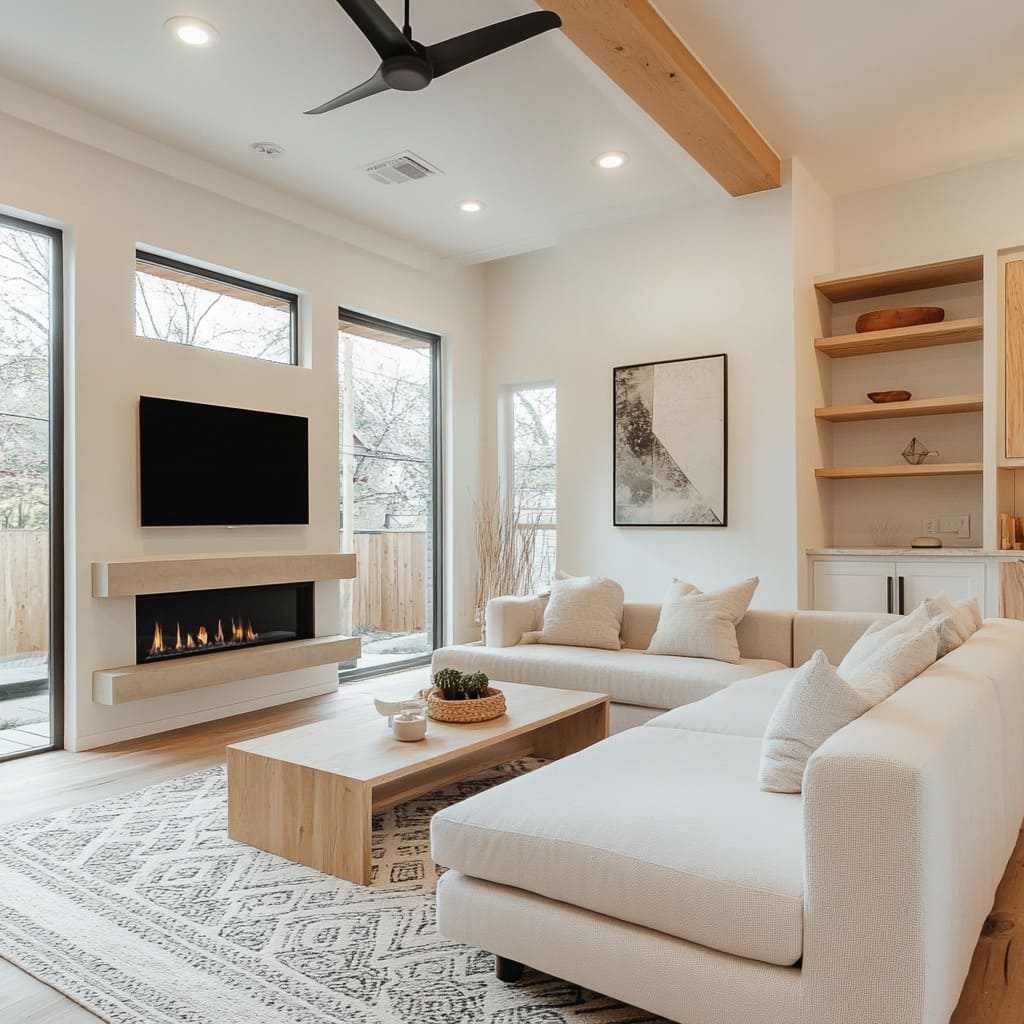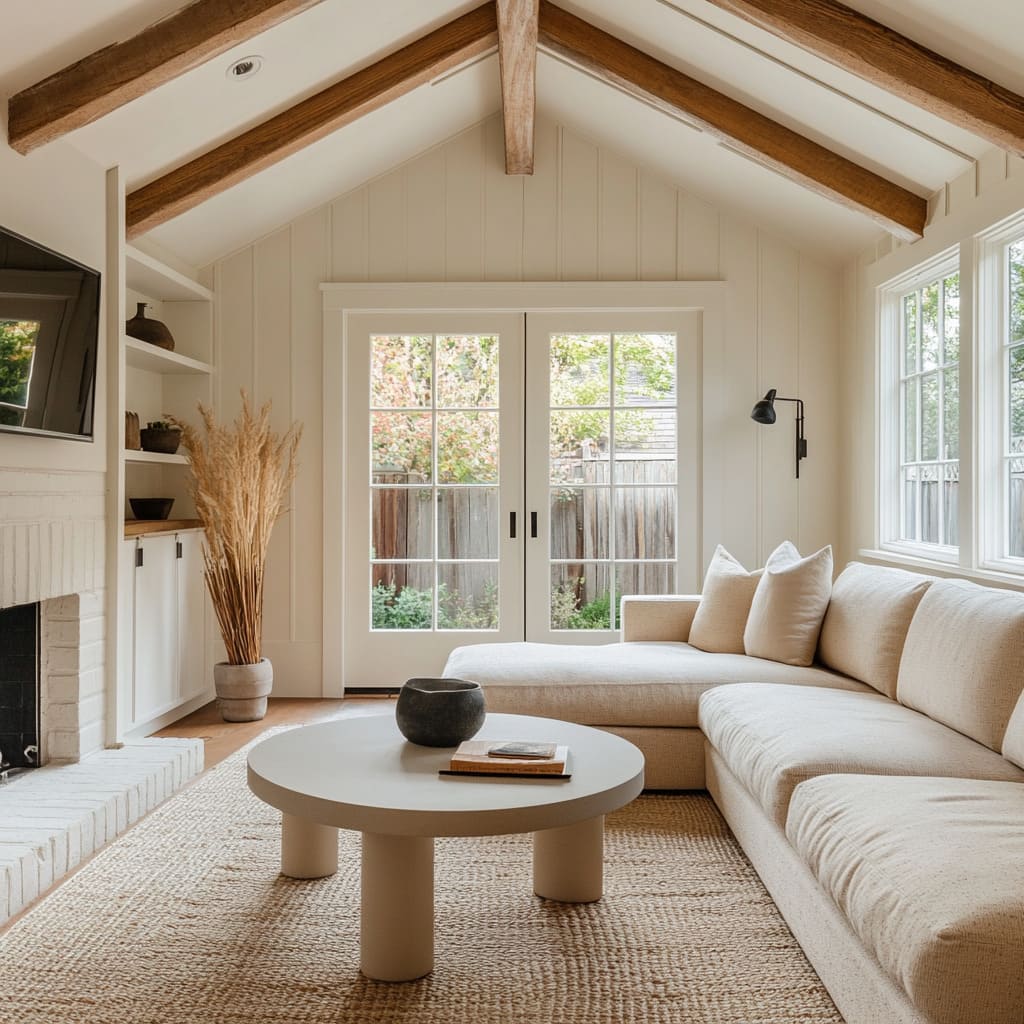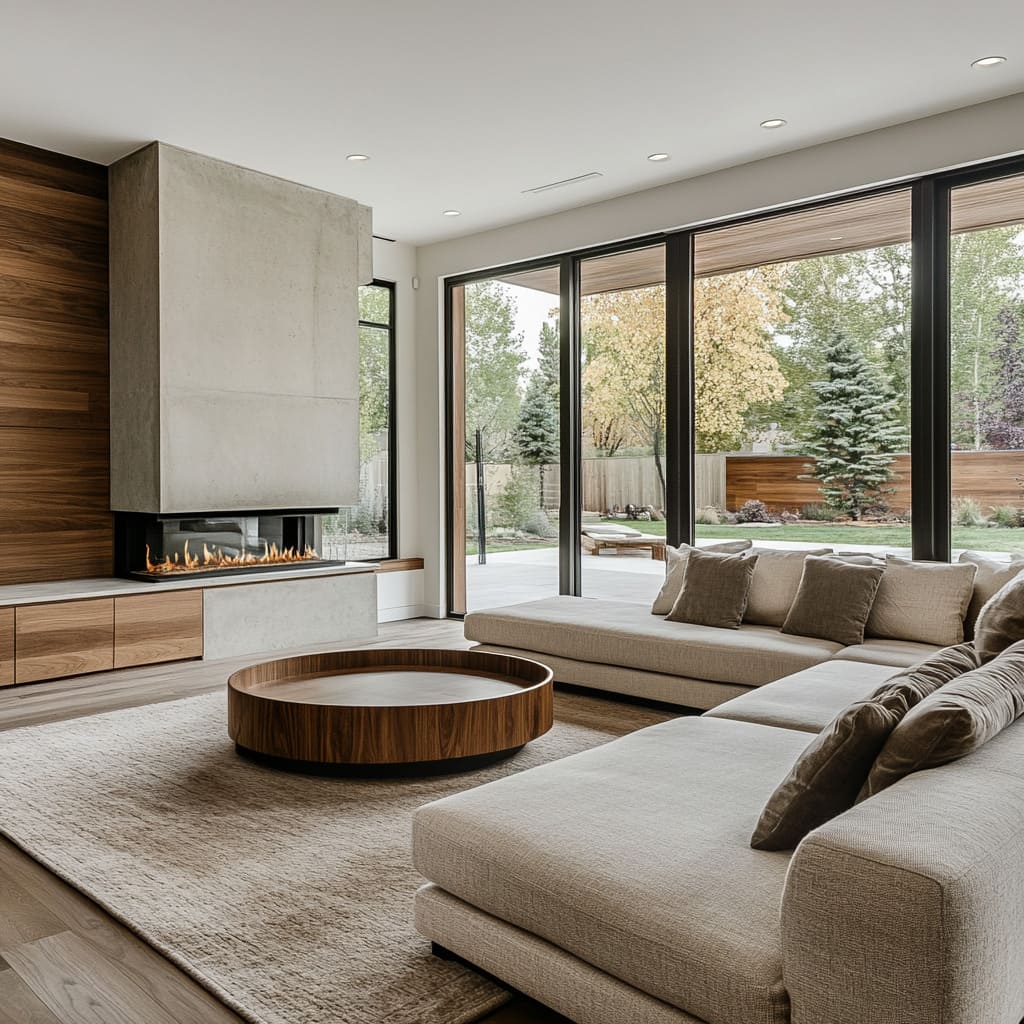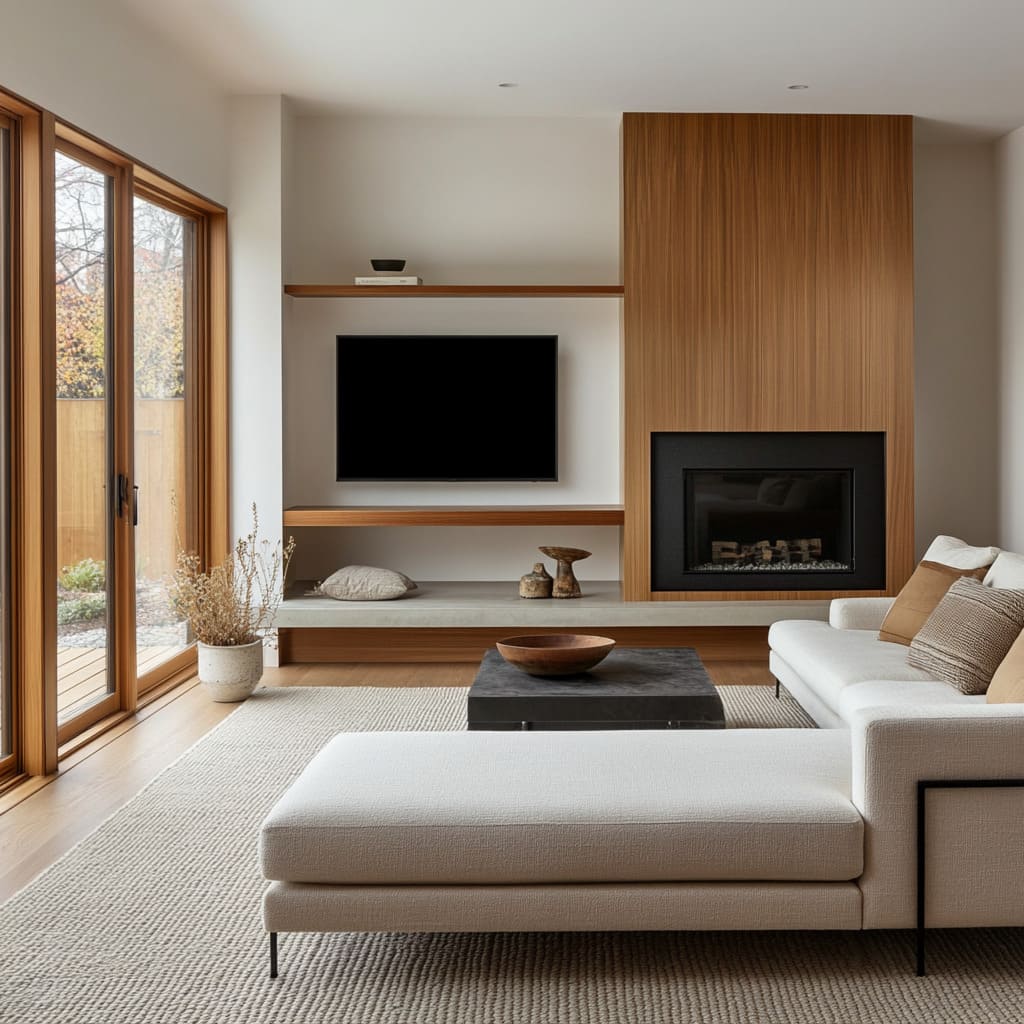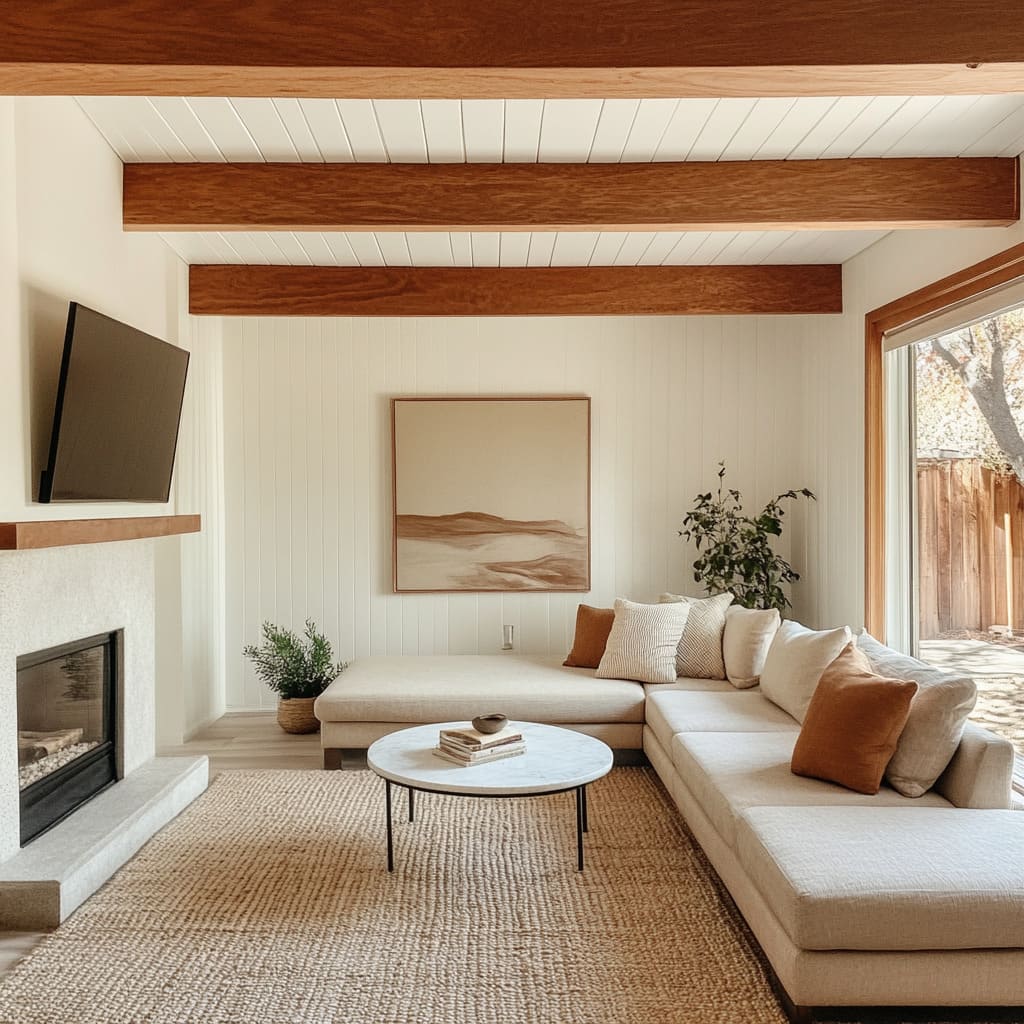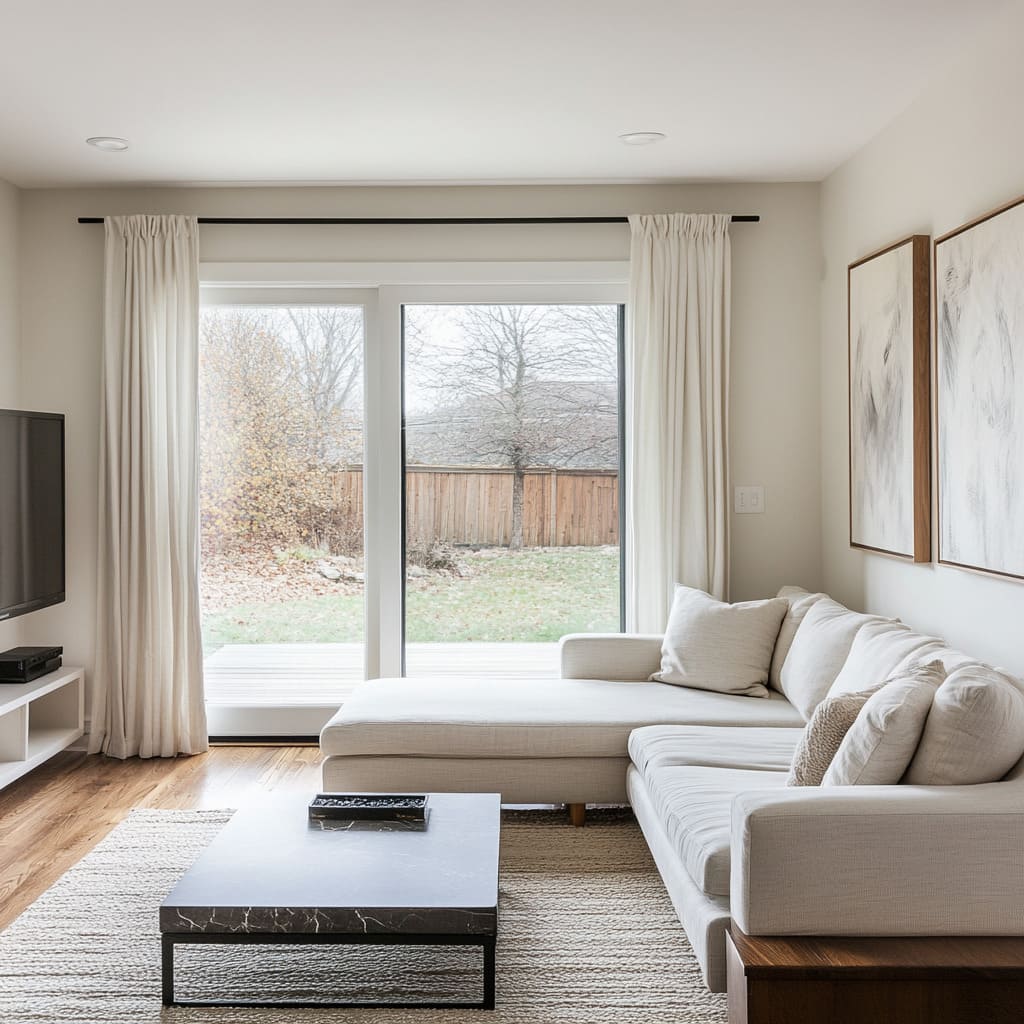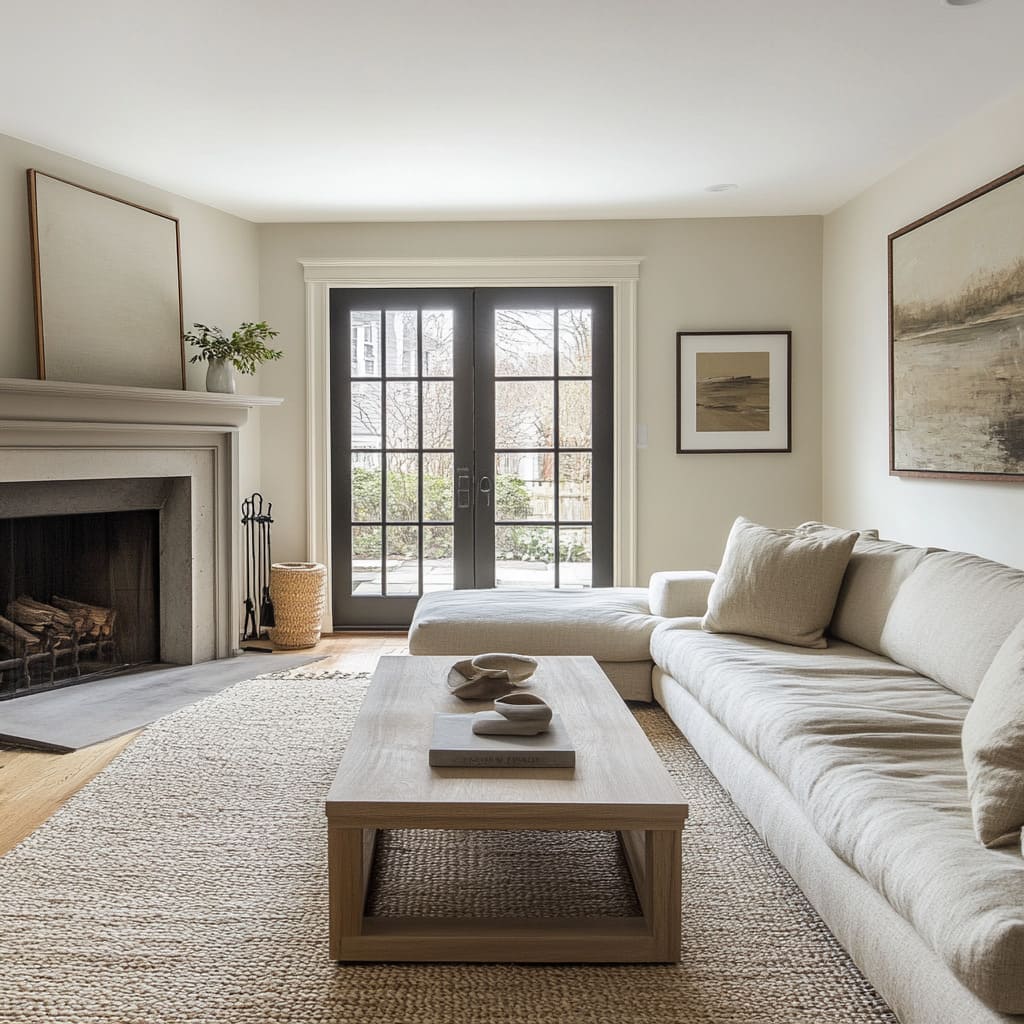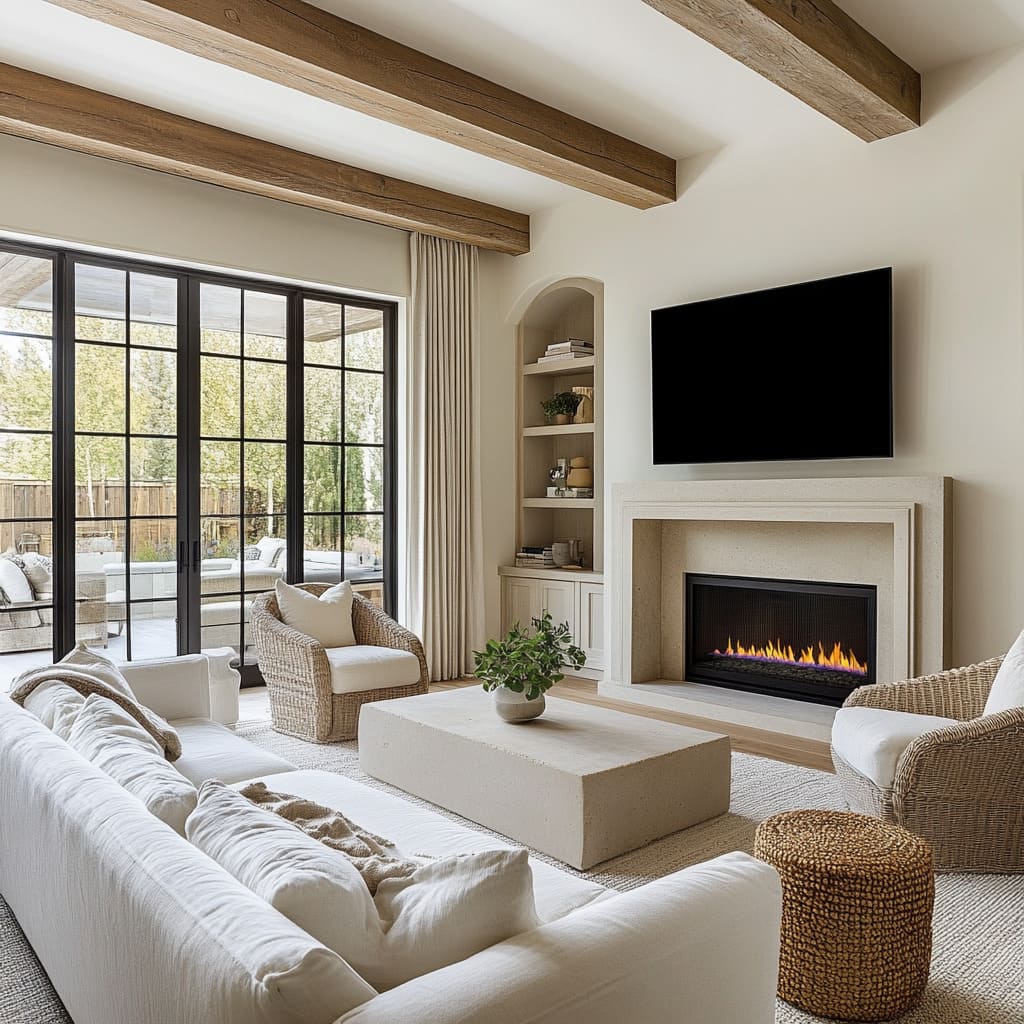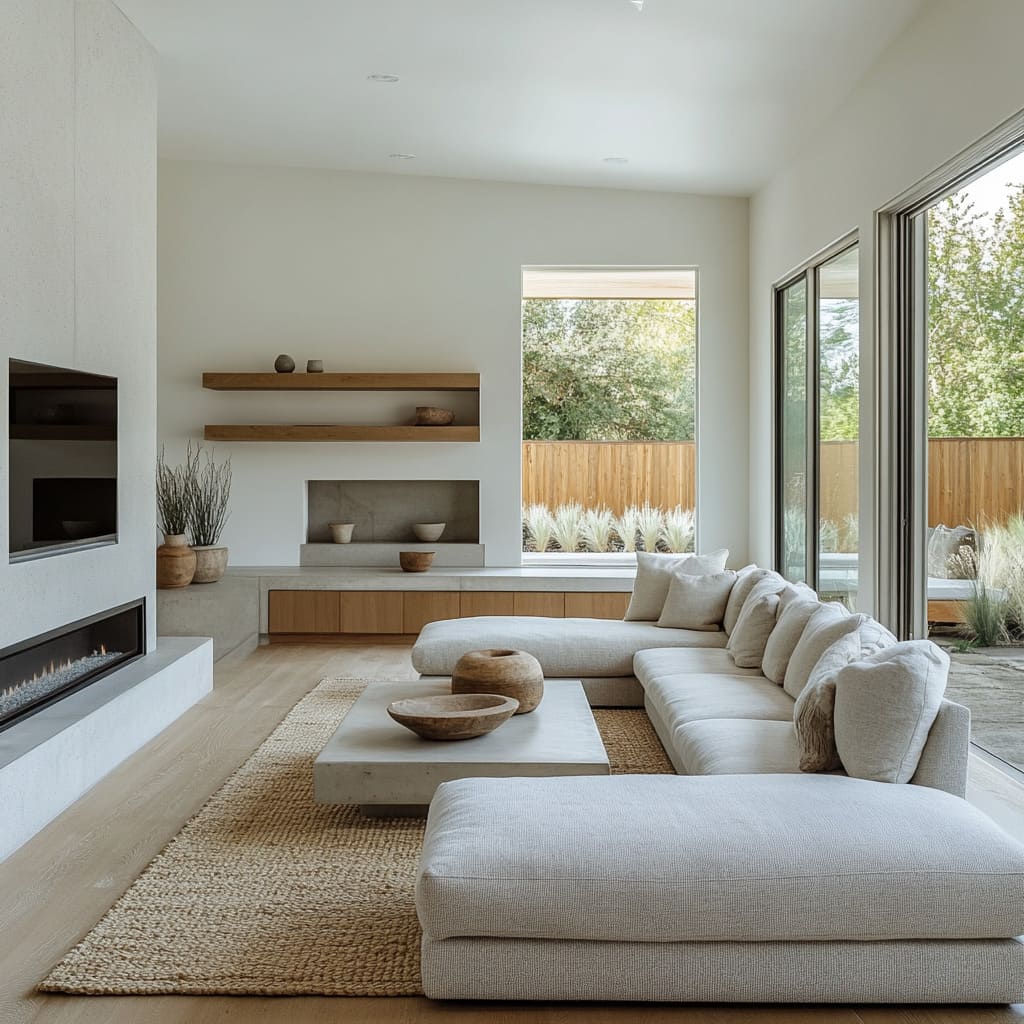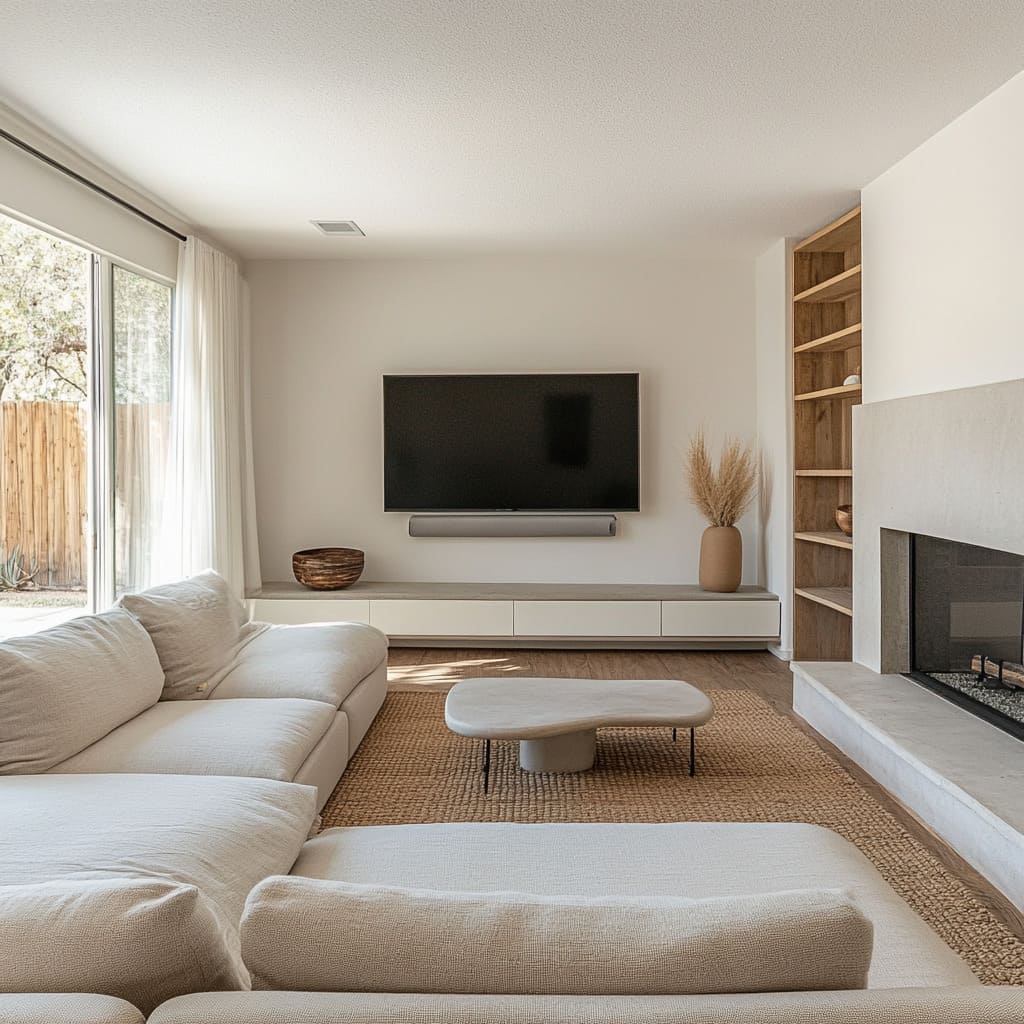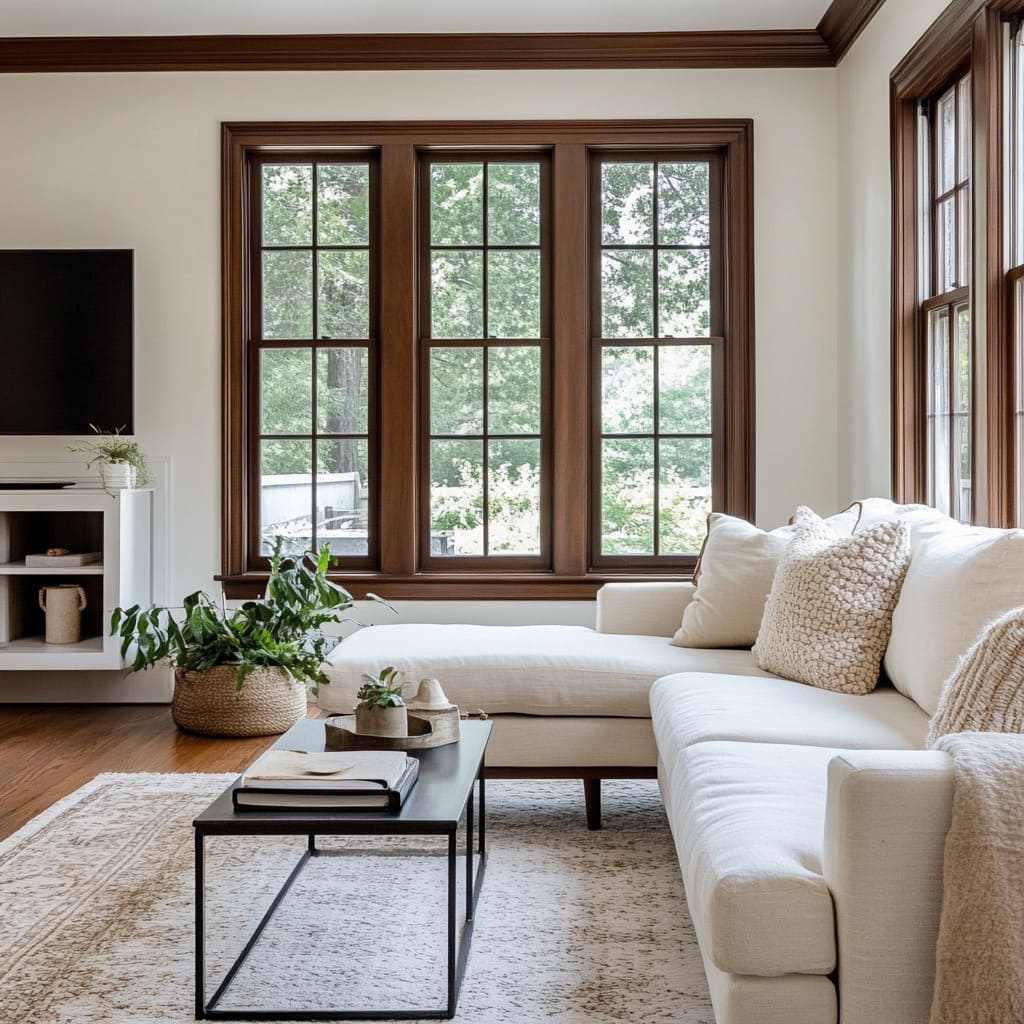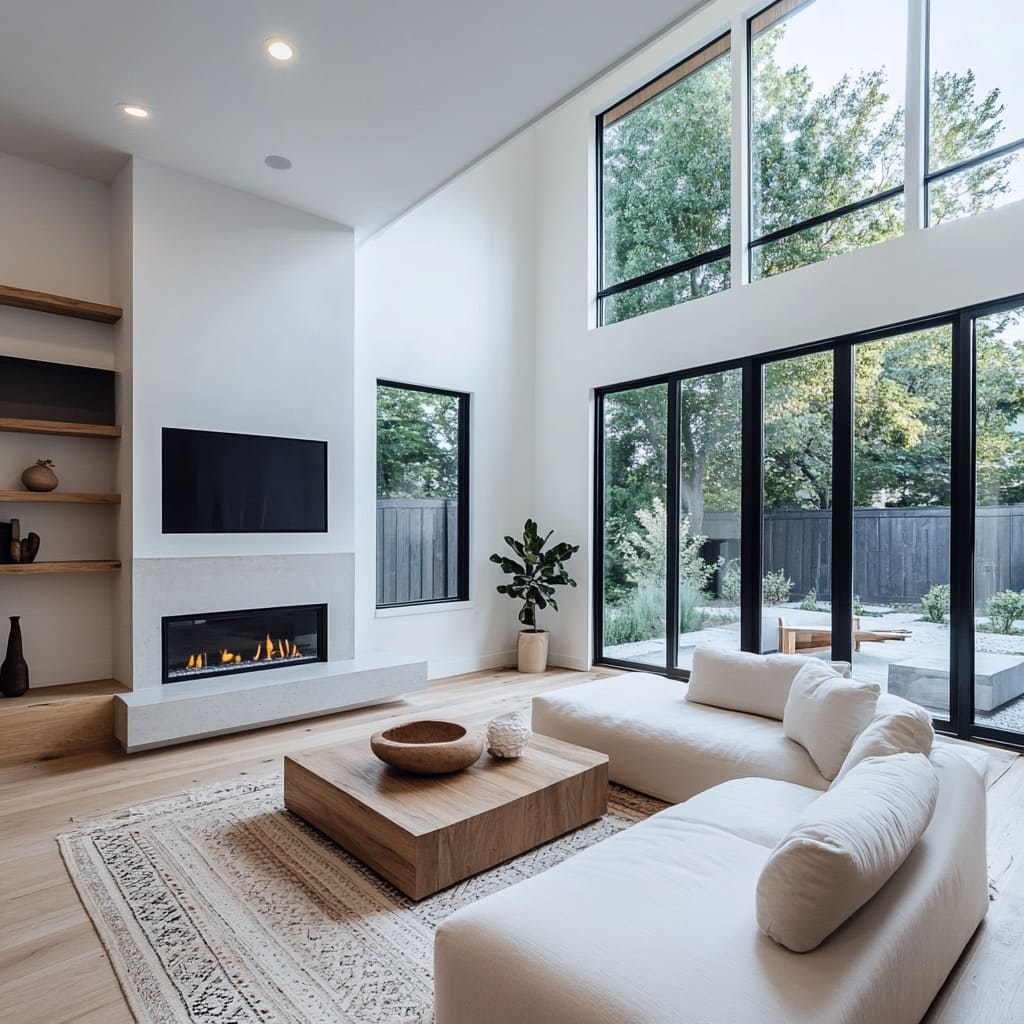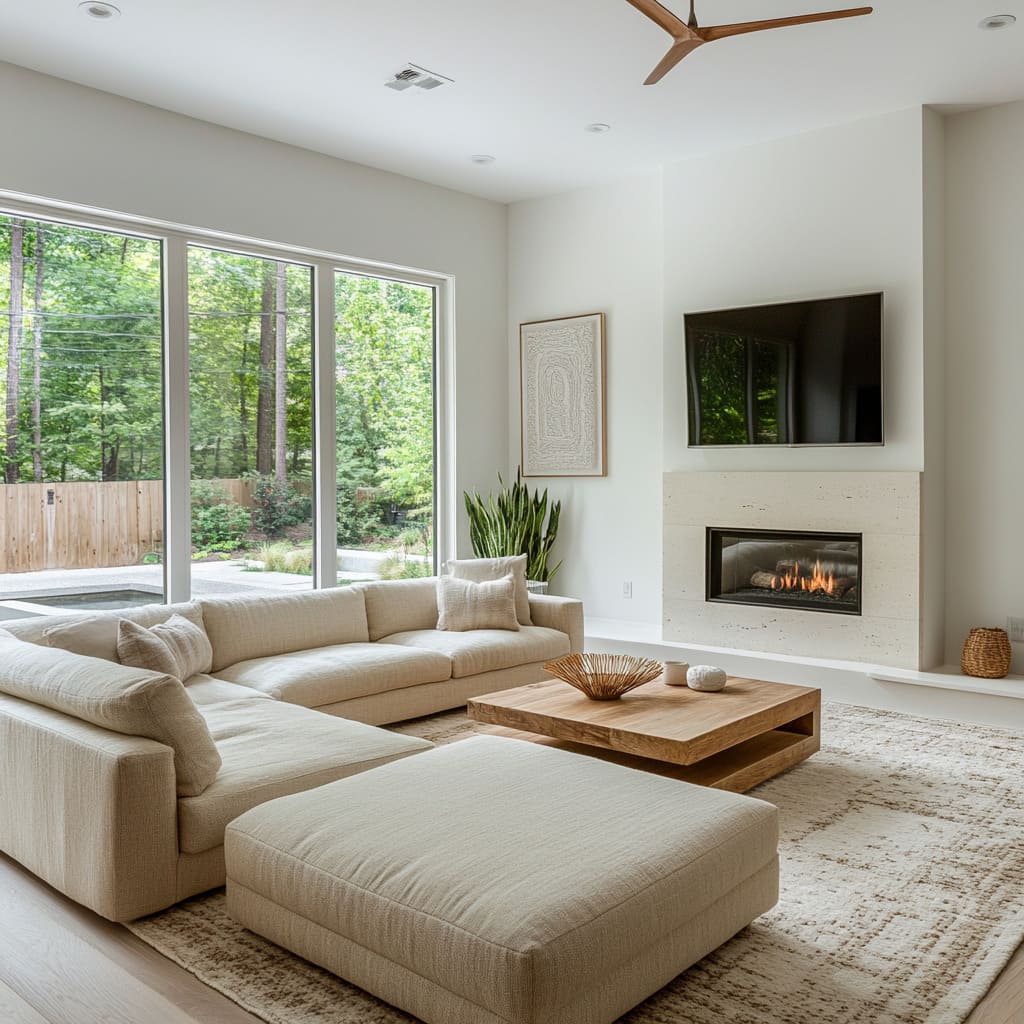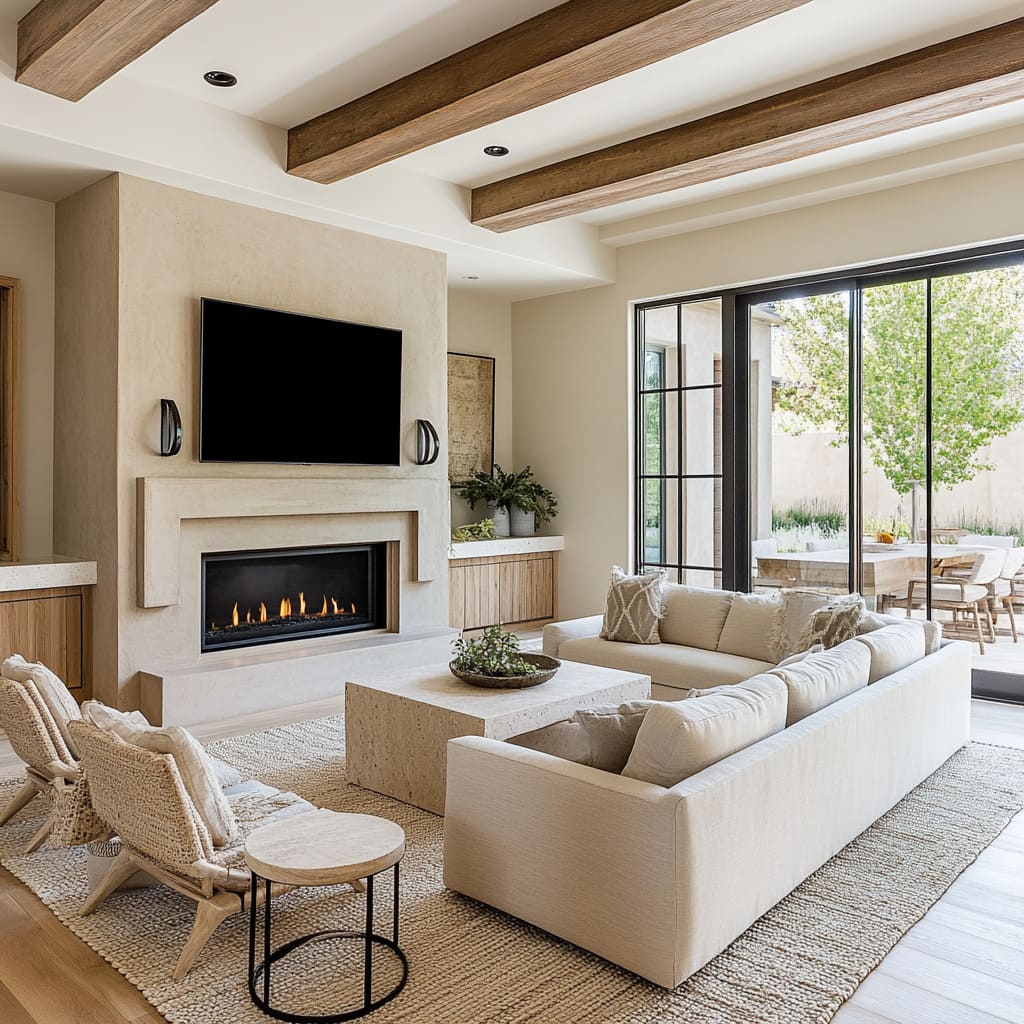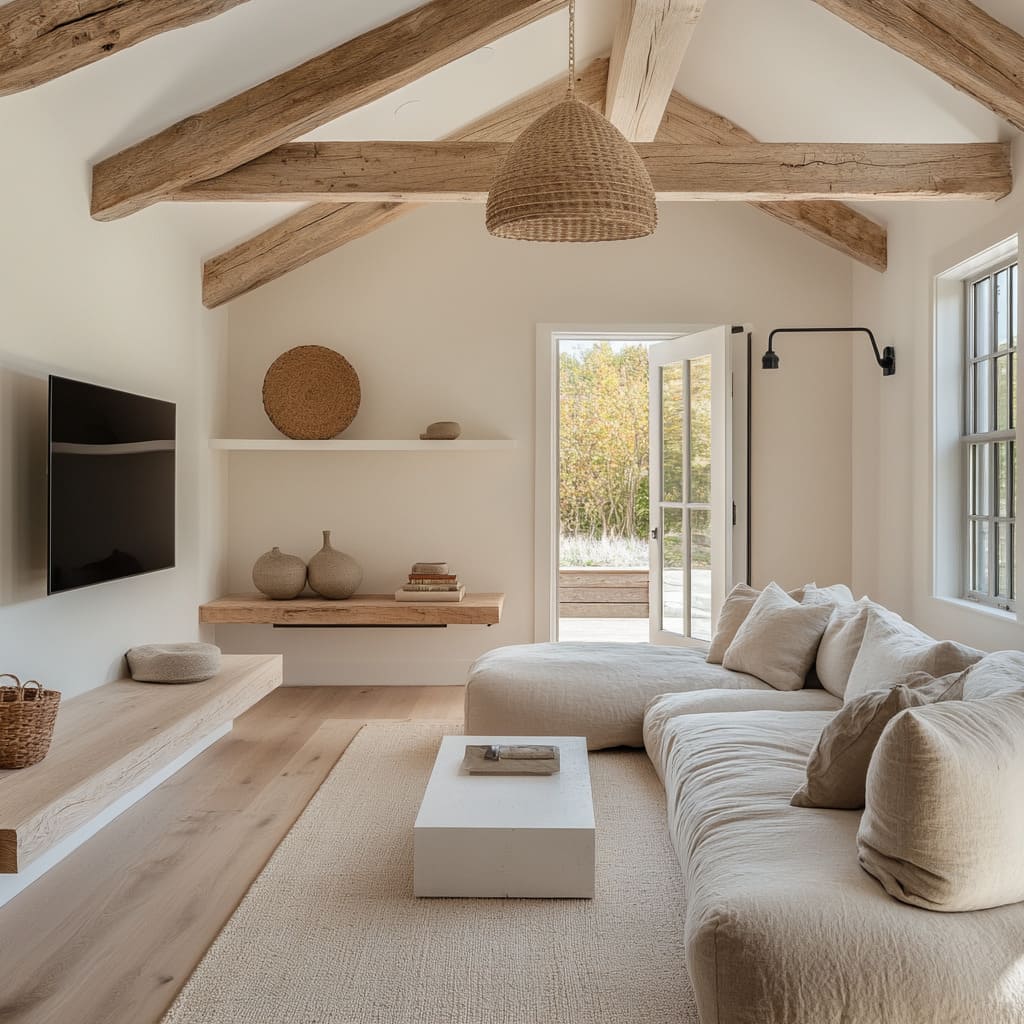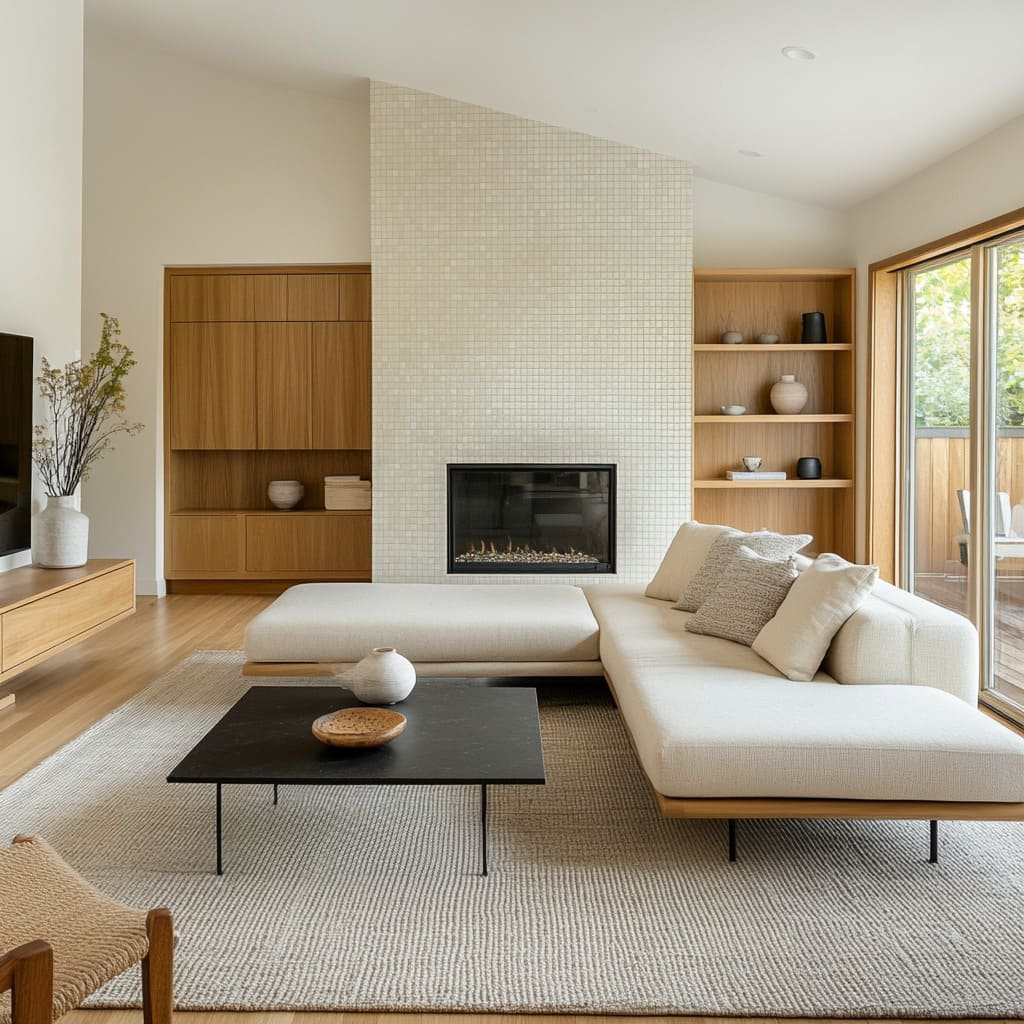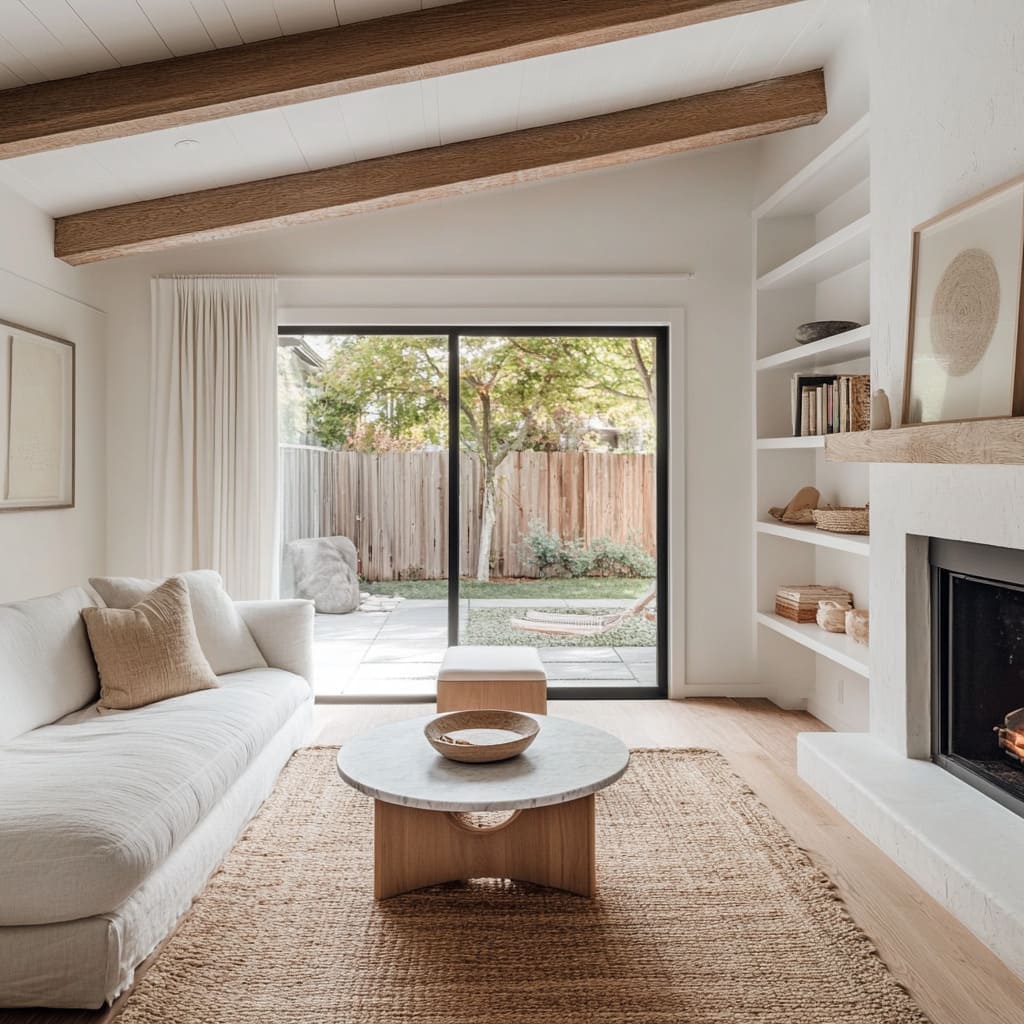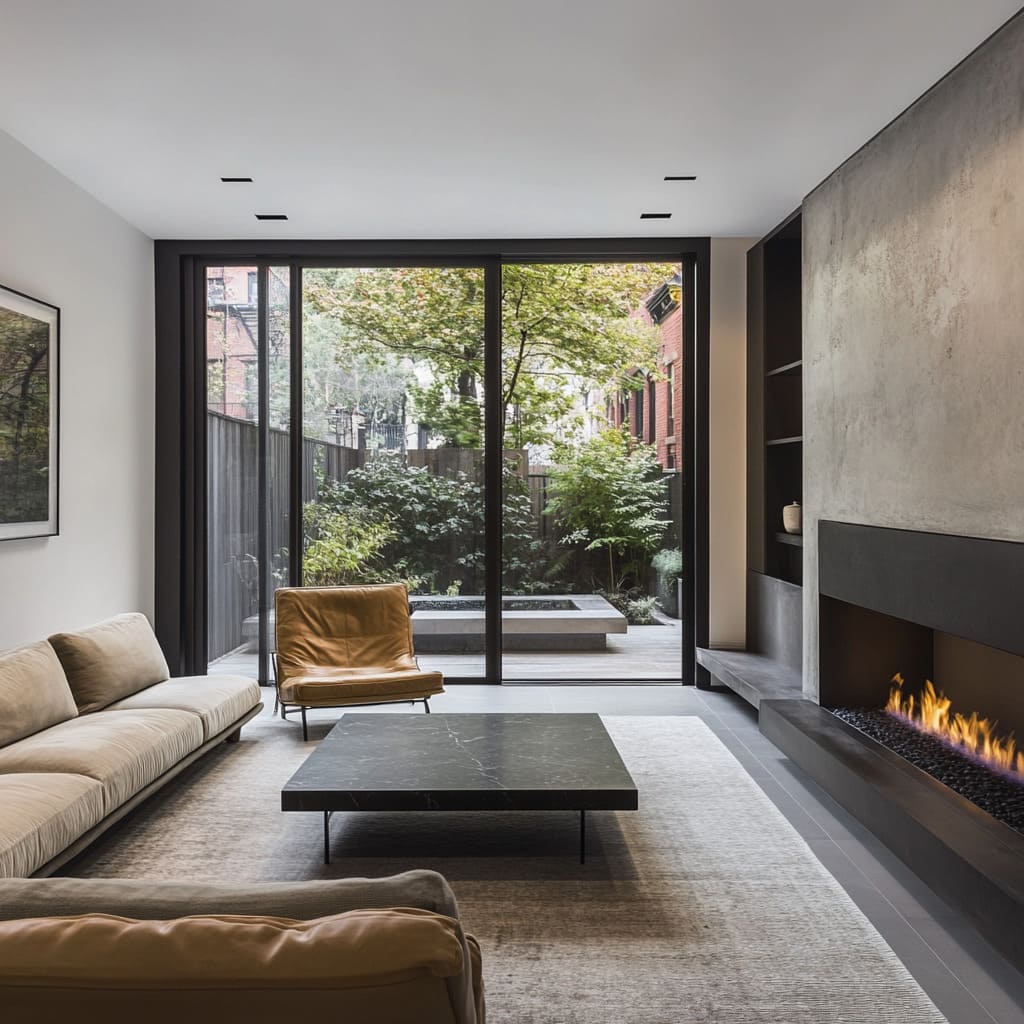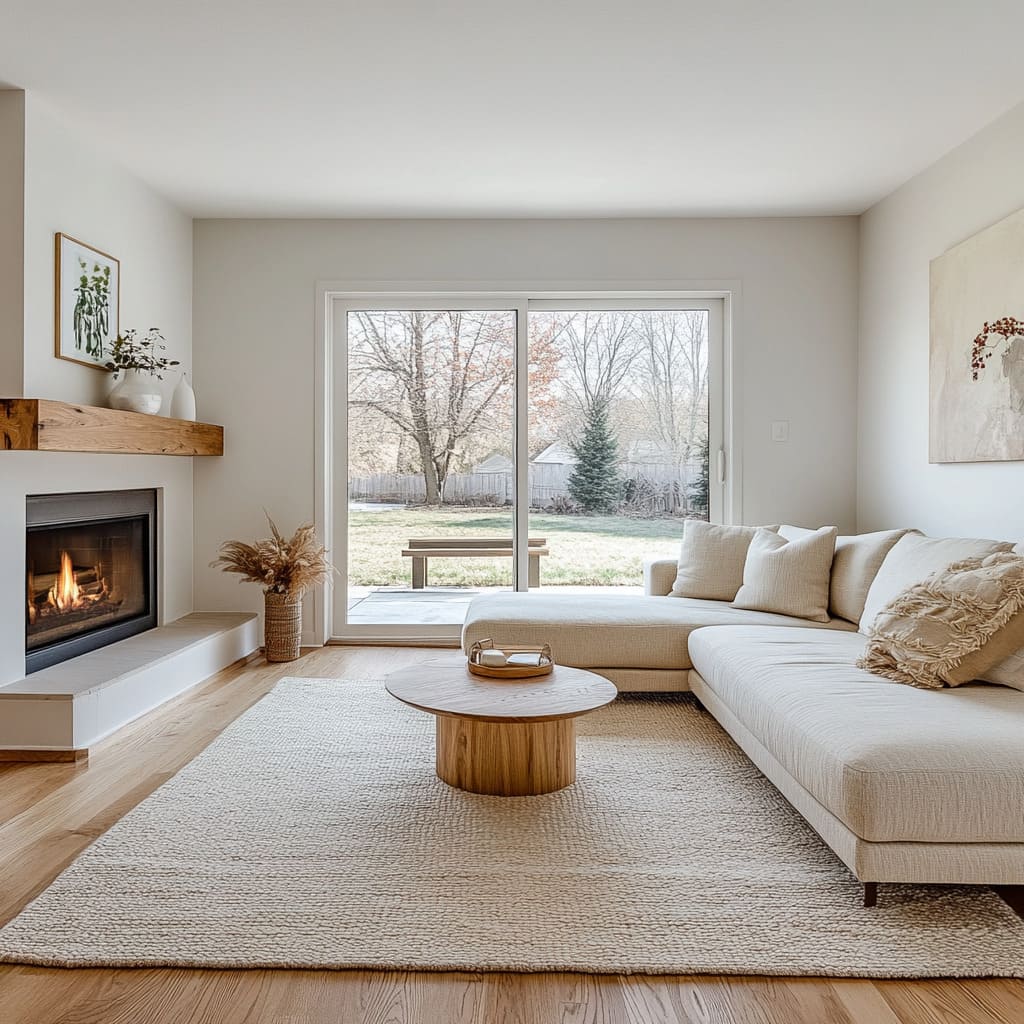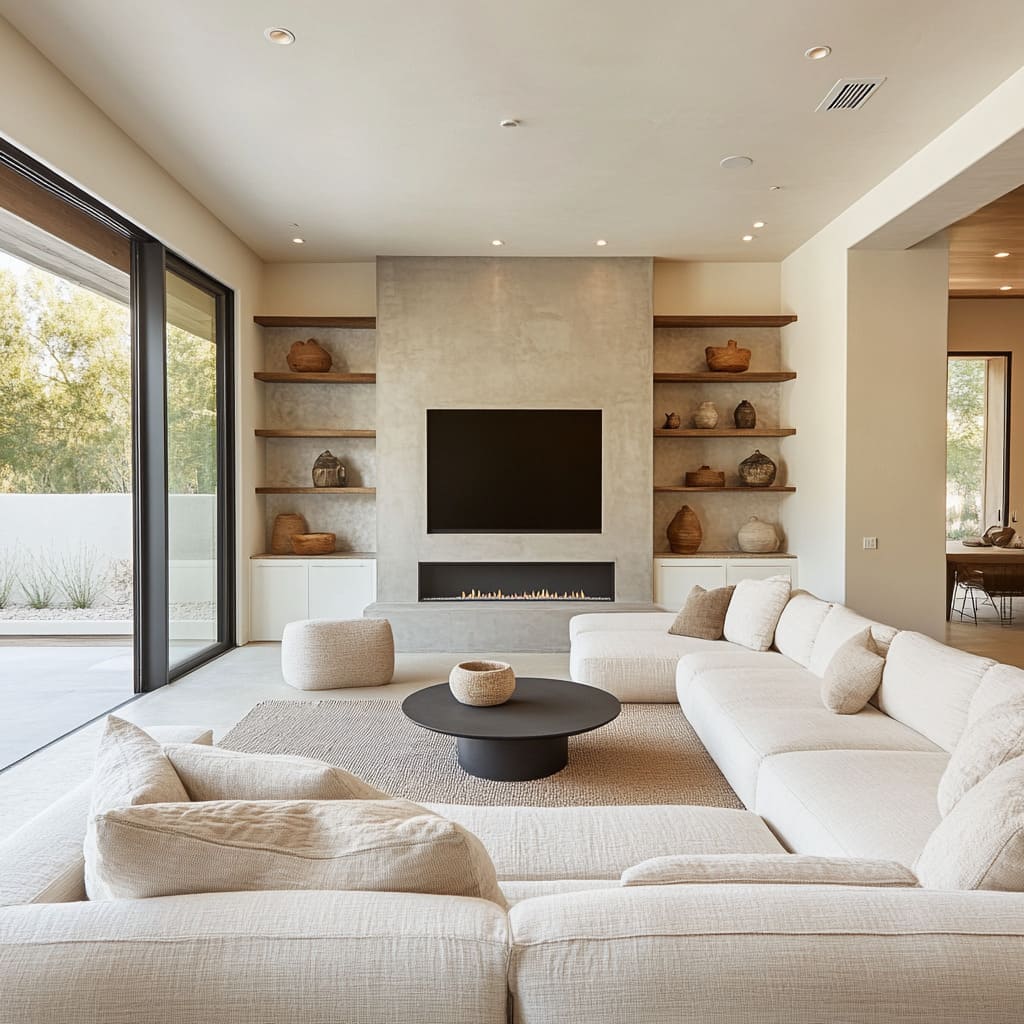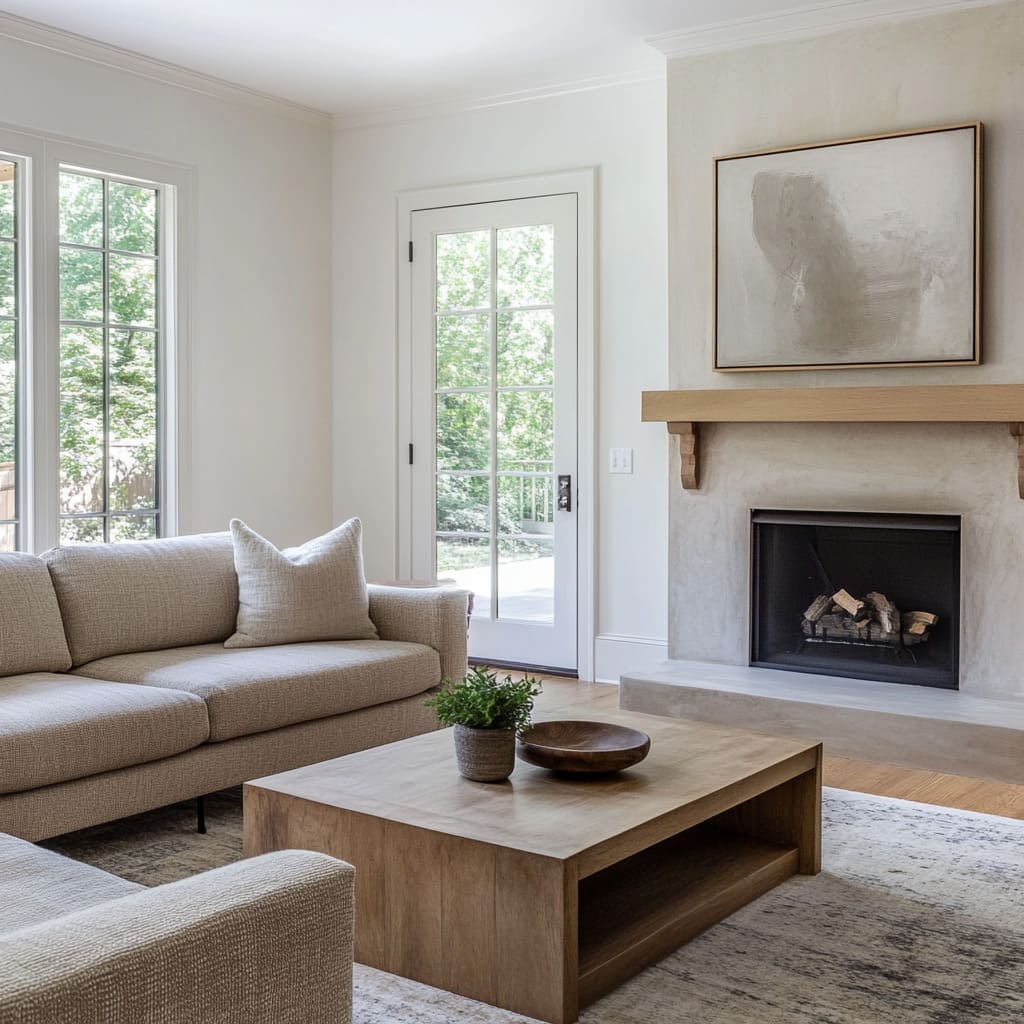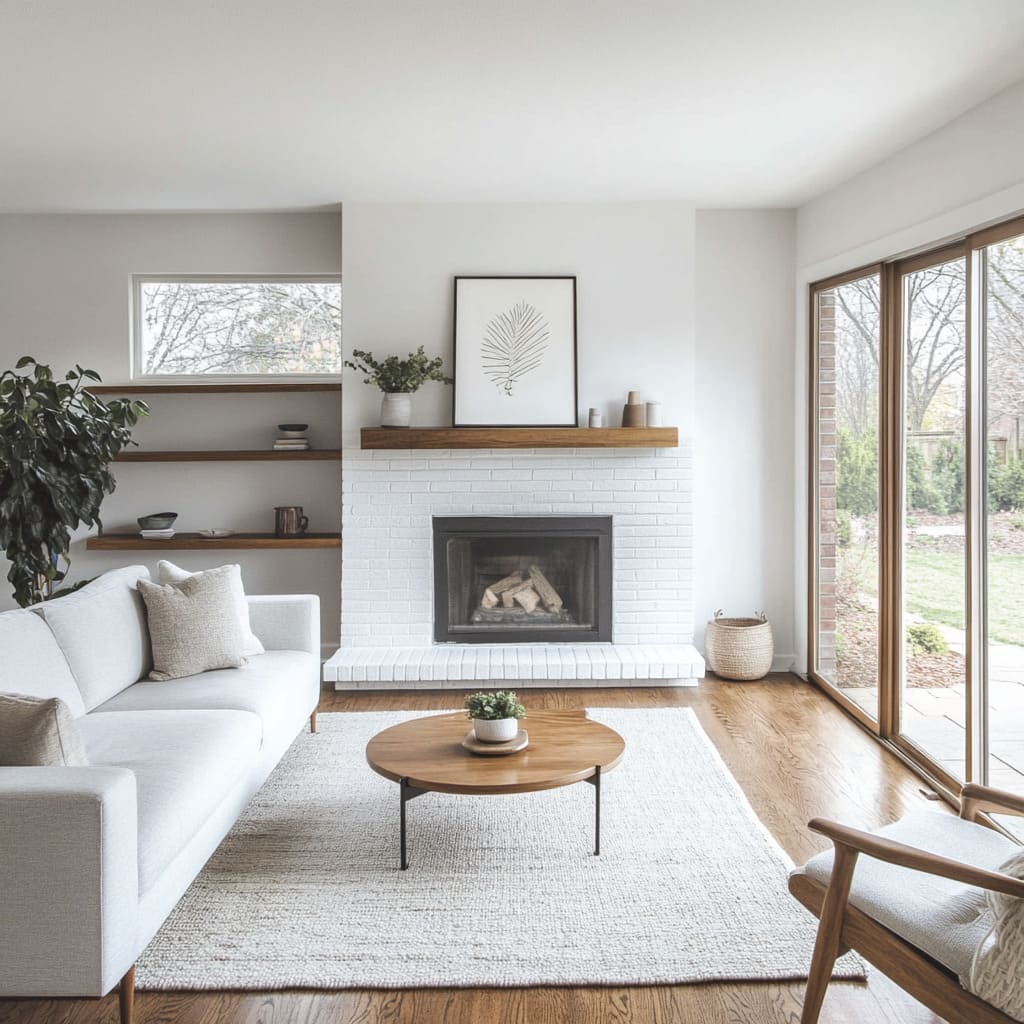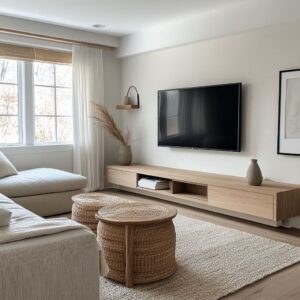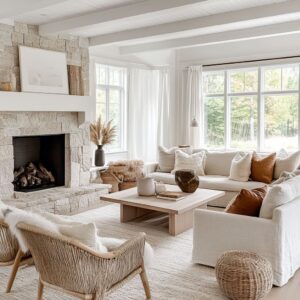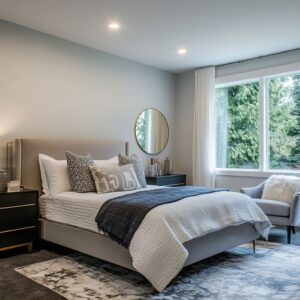Simplicity in décor doesn’t have to feel stark or cold—it can be surprisingly welcoming. By focusing on clean lines, soft colors, and a few well-chosen accents, even small spaces can appear brighter and more open.
In many homes across different regions, designers have found that embracing pared-down styles can highlight natural light and draw attention to unique architecture. If you’re searching for minimalist living room ideas that keep things modern but cozy, this overview will explore the key ingredients behind creating a space where every detail feels intentional.
Balancing Simplicity and Warmth
Balancing a bright palette with inviting textures is a key approach in many minimalist living room designs. It’s easy to assume that a pared-down look might feel stark, but blending neutral seating with touches of wood, stone, or concrete brings in a gentle sense of comfort.
Textured Upholstery
Opting for fabrics like soft linen or a subtle woven blend ensures the seating doesn’t appear too plain. Even a cream-colored sofa can include a pleasing weave that makes the eye linger, giving the entire room a warm depth.
Woven Rugs and Natural Fibers
Hard surfaces, such as polished concrete or hardwood floors, often need a tactile element to soften the overall view. That’s where jute or other woven rugs come in.
A subtle layer of natural fiber does more than keep feet cozy—it also balances out the clean lines and keeps the atmosphere from feeling lifeless.
Wood Accents
Whether it’s a coffee table, shelving, or overhead beams, wood remains a favorite for infusing a homey note. Its grain, knots, and natural color give the interior a hint of warmth that contrasts nicely with the lighter palette.
Repeating wooden details—from mantel to side table—ties the look together while steering clear of anything overly fussy.
Strategic Use of Contrast
Keeping colors minimal doesn’t mean everything has to blend together. Designers often insert dark accents, such as black marble tables or black metal trim on doors, to outline important features and give the eye a focal point.
These touches can also create a sense of depth in spaces that rely mostly on softer shades. Used sparingly—like a black curtain rod or a deep charcoal shelf—these darker notes prevent a washed-out look and bring a hint of boldness.
Shape contrast is another trick: if a sofa has softly curved edges, introducing a more angular coffee table makes each piece pop. This play on geometry keeps the overall palette unified but adds a subtle energy that appeals to the visual sense.
Such techniques are particularly effective in a modern minimalist living room, where carefully chosen contrasts can turn a simple setup into something remarkably inviting.
Emphasis on Architectural Features
Highlighting original or newly added structural elements can instantly draw focus in a pared-down space. A fireplace framed by sleek stucco, concrete, or limestone stands out on a bare wall, delivering visual intrigue without fuss.
Some designers install a floating mantel or opt for a linear gas insert, letting the material itself be the real attraction. In older homes, wooden beams or vaulted ceilings can stay exposed, sometimes in a natural finish or lightly stained.
Their lines contrast with pale walls and modern furnishings, providing an extra layer of character above. They’re often left bare to keep the look grounded and visually captivating.
Built-in shelving is another way to give architectural interest. Painted to match the walls or clad in wood, these units hide away clutter but also offer display space for a handful of artful items.
Simple ceramic pieces or a single framed print can stand out beautifully against the clean backdrop, keeping the overall look open and intentional.
Indoor-Outdoor Visual Flow
Floor-to-ceiling windows or sliding doors do more than brighten a room—they also make any view outside part of the interior’s overall look. Natural light can easily sweep in, reducing the need for overhead fixtures, while a glimpse of greenery or a simple fence feels like a living backdrop.
One of the best ideas for minimalist living room spaces is to coordinate door or window frames with other design elements, such as using matching metal finishes or wood tones found in shelves or mantels. This creates a sense of unity that looks effortless.
As for the outdoor area itself, a neutral or pared-down scene—like a single bench or a few well-placed plants—keeps the aesthetic cohesive. It’s a way to extend the interior mood outward, ensuring both sides feel connected and balanced.
Thoughtful Lighting Approaches
Soft, indirect lighting can make all the difference in a minimalist living area, especially for those who prefer a tranquil vibe without bulky fixtures overhead. Designers often opt for recessed ceiling lights or small fixtures around the fireplace to preserve clean lines.
This way, the space looks cohesive by day, thanks to natural daylight, and gains a gentle glow in the evening without drawing too much attention to the fixtures themselves.
Meanwhile, function-focused lamps—like a wall-mounted reading light or a sleek floor lamp—provide targeted illumination where needed. They’re usually chosen in darker finishes to keep visual clutter low and to align with the overall palette.
By staying unobtrusive, these choices enhance the room’s sense of calm without overpowering other design elements.
Curated Minimal Decor
Minimalist living room decor ideas revolve around carefully selecting just a few key objects that make a statement. In these spaces, less truly is more.
With fewer items, every piece carries more weight. Sculptural vases, potted plants, or even a simple bowl can become the focal point in an area, strategically placed to take up negative space and allowing the eye to rest on the singular item.
Organic materials play a significant role in maintaining a harmonious aesthetic. Ceramic vases, woven baskets, dried pampas grass, or fresh succulents bring a hint of nature indoors while blending seamlessly with the room’s neutral tones.
These materials provide texture and depth without overwhelming the simplified palette, emphasizing subtlety over bold colors.
When it comes to artwork, it serves as a secondary accent rather than demanding attention. More often than not, it’s a piece that embodies calm with its muted tones, abstract shapes, or minimalist lines.
Whether casually leaning against a mantel or minimally framed and hung on a wall, artwork in minimalist rooms doesn’t compete for attention—it complements the tranquil atmosphere. This type of decor keeps everything streamlined, yet still visually appealing.
Subtle Layering for Visual Depth
Minimalist spaces often appear straightforward, but a deeper look reveals layers of textures and thoughtful design choices that bring the environment to life. When layering textiles, designers might use a linen slipcover on a sofa and complement it with a throw pillow in woven wool or a chunky knit.
The trick is in the subtle blending of tones that add dimension while avoiding harsh contrasts. This technique creates visual depth without complicating the room’s overall harmony.
The contrast between structured and plush elements is another common approach. A blocky coffee table or sharply edged media units might sit comfortably alongside softer seating or plush rugs.
This juxtaposition ensures the room remains dynamic, with comfort balanced by the occasional geometric sharpness, preventing it from feeling overly stiff.
Material continuity further enriches the space. Repeating materials within the design—like wooden mantels, beams, and matching tables—ensures everything feels connected.
Similarly, stone elements in the fireplace find their way into other furniture pieces, such as the coffee table or even the tiles, tying everything together visually. For anyone searching for minimalist ideas for living room spaces, this attention to material detail offers a cohesive flow that enhances simplicity without feeling bland.
Tailoring Minimalism to Different Eras of Home Construction
Older homes each bring their own quirks that can blend beautifully with a pared-down approach. In a 1970s ranch house, architects often add wide sliding doors and airy paint colors to maximize limited square footage, while a simple floating mantel or a painted brick fireplace updates the original brickwork.
With a 1950s bungalow, there’s usually an emphasis on retaining elements like timber beams or rustic floors but combining them with bright walls and clean-cut furnishings. This mix creates a warm contrast between traditional charm and modern streamlining.
Moving into an urban brownstone, darker tones and concrete details might be favored for a chic city feel, with minimal accessories to avoid a cramped ambiance. Large windows or a small patio can still bring in enough light and a glimpse of greenery.
In a cozy cottage, painted brick fireplaces paired with wooden mantels speak to the home’s heritage, while plush sofas and woven rugs offer an easy, lived-in balance. Whether one’s style leans toward retro or metropolitan, these variations show that minimalist living room ideas can adapt to many architectural backdrops without losing their sense of ease.
Optical Tricks for a Spacious Look
Making a small room feel surprisingly open often comes down to design choices that trick the eye. One popular tactic is selecting sofas and chairs with a lower profile.
Because these pieces sit close to the floor, the ceiling suddenly appears higher. Choosing furniture with slim legs—especially metal or slender wooden ones—further exposes floor space, giving the impression of more square footage.
Another strategy is sticking to a consistent palette of soft neutrals on walls, ceilings, and major furnishings. By blending similar shades of white, cream, or gray, you avoid the strong edges that can define and shrink a space.
This subtle blending helps the entire room read as one continuous sweep of color.
Finally, letting natural light flood in through large windows or glass doors can work wonders. Many designers skip heavy drapes and opt for sheer curtains instead.
The result is a bright, airy interior that feels far bigger than its measurements might suggest. Even modest homes can appear bright and inviting when the sun is free to pour in.
Subtle Personalization
Even within a minimalist style living room, you can introduce subtle personal touches to reflect individuality without disrupting the overall calm. For instance, clusters of books or carefully placed ceramics can add personality to a space.
These items, chosen for their color scheme and design, serve as understated markers of the homeowner’s tastes. When arranged thoughtfully, they don’t overwhelm the room but rather become part of the room’s organic flow.
Houseplants are another simple yet effective way to inject life and uniqueness into a space. Whether it’s a singular sculptural plant like a fiddle-leaf fig or smaller, more subtle succulents, each choice can reflect personal preference.
Their green tones bring a fresh energy that complements minimalist decor while maintaining a serene vibe.
Art, often abstract or muted in color, also plays a role in personalizing the room. These pieces are selected with intention—they blend in with the environment rather than dominate it.
Art in minimalist rooms is rarely bold with bright colors or intricate patterns; instead, it harmonizes with the room’s serene backdrop, contributing a subtle but meaningful accent to the space. Such touches ensure that, although the room remains minimal in its furniture and design, it still feels like a personal haven unique to its inhabitants.
Conclusion
Creating minimalist living rooms in typical American homes involves a fine balance of materials, intentional design, and a well-considered color palette. It’s easy to think of these spaces as simply clean and white, but there’s much more happening behind the scenes.
By using soft wood tones, stone, and textiles with muted hues, designers create a calm, inviting feel that doesn’t overwhelm.
These rooms may seem simple, but take a closer look and you’ll find layers of texture, thoughtful contrasts, and purposeful integration of architectural features. The final result isn’t just a neat design but a space that flows naturally, providing both comfort and powerful visual appeal.
Minimalism works here because of the attention to detail and the consistent use of materials, making each room feel like a welcoming, peaceful corner of the home. The quiet elegance of these interiors seamlessly binds practicality and aesthetics, making everyday living feel effortlessly pristine.
